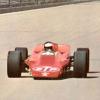Ferrari F1-2000 pictures
#1

Posted 08 May 2004 - 15:35
http://tinypic.com/24c5
Engine cut-away drawing
http://tinypic.com/24ch
Engine cross-section drawing
http://tinypic.com/24ci
Footwell
http://tinypic.com/24c9
Rear suspension
http://tinypic.com/24br
Back
http://tinypic.com/24c7
#3

Posted 08 May 2004 - 15:53
#4

Posted 08 May 2004 - 17:14
j.
#5

Posted 08 May 2004 - 17:28
#6

Posted 08 May 2004 - 18:49
The old adage, "A picture is worth a thousand words." seems woefully inadequate to describe the brilliant Tony Matthews cutaway illustrations, I simply must have that book!
And is it just coincidence that what is inarguably the best team in F1 over the last few years is also inarguably from my perspective the classiest as well, the only one who isn't utterly infected with irrational institutional secrecy and paranoia? Ferrari are and have been far and away the most forthcoming with the technical details of the F1 cars they build. Can you even imagine any of the other teams granting such access to the inner workings of their effort? Hasn't seemed to hurt them or helped their less enlightened competitors has it?
#7

Posted 08 May 2004 - 21:05
#8

Posted 08 May 2004 - 23:21
Originally posted by desmo
My vote for best post of the year, thanks perfectelise!


And is it just coincidence that what is inarguably the best team in F1 over the last few years is also inarguably from my perspective the classiest as well, the only one who isn't utterly infected with irrational institutional secrecy and paranoia?
My old boss, pre-medical school when I worked in London, used to be the MD of Shell Coal. Obviously a reasonably large company - it was, anyway.
He said the exact same thing. When times get hard, the companies that open most (within reasonable limits) stimulate ideas, adapt, and succeed. Companies that exhibit outward secrecy by no means leave their paranoia at the gates of the company HQ - people are known to want to move ahead of time, and so are cut out of the loop - this guarantees they move, and it means that the engineer concerned is lost well before he ever leaves the company - he's an empty desk once you don't give him the info.
Alex
#9

Posted 09 May 2004 - 15:02
#10

Posted 09 May 2004 - 15:55
#11

Posted 09 May 2004 - 16:02
I wish we could see the pretty bits of the Williams and Macs too
#12

Posted 09 May 2004 - 20:17
In the gearbox, what is the reasoning for having the pinion mesh with a small gear that drives the differential assembly? My guess would be to move the diff up thereby moving the rest of the gears down??? How can they get away with such narrow gears? Is it because the torque output is relatively low? Having said that, these engines are still putting out several hundreds of lb/ft.
What book is this from and where do I buy it?
#14

Posted 10 May 2004 - 16:00
Originally posted by ciaoduc
I love drawings like these.
In the gearbox, what is the reasoning for having the pinion mesh with a small gear that drives the differential assembly? My guess would be to move the diff up thereby moving the rest of the gears down???
Exactly. That, and providing a third stage reduction to turn ~18Krpm into ~2.5Krpm at the rear wheels.
#16

Posted 15 May 2004 - 12:15
#17

Posted 15 May 2004 - 12:26
#18

Posted 27 May 2004 - 17:28
http://tinypic.com/24ci
some sort of crankcase ventilation between crankcases?
#19

Posted 27 May 2004 - 17:44
Advertisement
#20

Posted 27 May 2004 - 20:39
Interesting to see dual oil squirters for each piston. Lightened gerotor is also interesting. Right hand side of drawing shows something that looks like a housing for a gear type oil pump. Does the book say anything about two different type of oil pumps??
I would think that if this engine has a oil pump for each section, and each bay or section of the engine is separate from another (ie - 5 sections total - one for each crankpin), then I believe you will have lower losses without a hole between each bay. So perhaps it's a plug, after something has been machined?
#21

Posted 27 May 2004 - 21:01
It looks like it might be a "puke tube" for the coolant. I think the rules actually state that the "puke tubes", although I'm relatively certain that isn't the terminology used in the regsOriginally posted by MRC
The plumbing bits in the airbox--- one part looks like a pressure relief valve.
Some of those sections in the gerotor look mighty scant don't they? And I cannot recall seeing such a exaggerated diffuser section btween the EX port outlets and the header proper in a four stroke before although that might be more an effect of transitioning between the dual port outlets and the more circular header cross section and the perspective angle of the drawing I suppose.
And nice to see you back posting MRC
#22

Posted 27 May 2004 - 22:20

1. ? looks like one of the parts is a coolant temperature sensor, one is perhaps a pressure relief valve
2. ?
3. ?
4. Oil jets for piston cooling
5. Air-oil separator, generator, pneumatic pump (71.5% of engine speed)
6. 11 eaton-type scavenge pump, 10 for the crankcases (2 per crankcase) and 1 for the head and timing gear case (35.5% of engine speed)
7. Oil duct from/to ?
8. Gear pump for oil pressure (1 eaton-type pump can also be used)
9. 1 eaton-type scavenge pump for head and timing gear case (32.5% of engine speed)
10. Control valves for the pneumatic valve return system
11. Electro-hydraulic actuated variable inlets
12. Oval elecro-hydraulic actuated butterfly throttles, one shaft for each bank
13. Oil return from the cylinderhead
14. Oil duct from/to ?
The axial main bearing is placed on the third main bearing, from the front if one looks at the engine cut away drawing but from the rear it seems if one looks at the pictures on page 99. Seems like the shells are secured to the crankcase with a screw.
On this picture it seems like the valve guides take up some space in the ports, if one looks at the pictures on page 98 that seems not to be the case.
On this picture it seems like the oil pressure pump is of gear type, on the engine cut away drawing an eaton-type pump is used.
Please feel free to add or cerrect anything on the list above.
Shall try to scan a few interresting photos from the book later.
#23

Posted 28 May 2004 - 17:19















